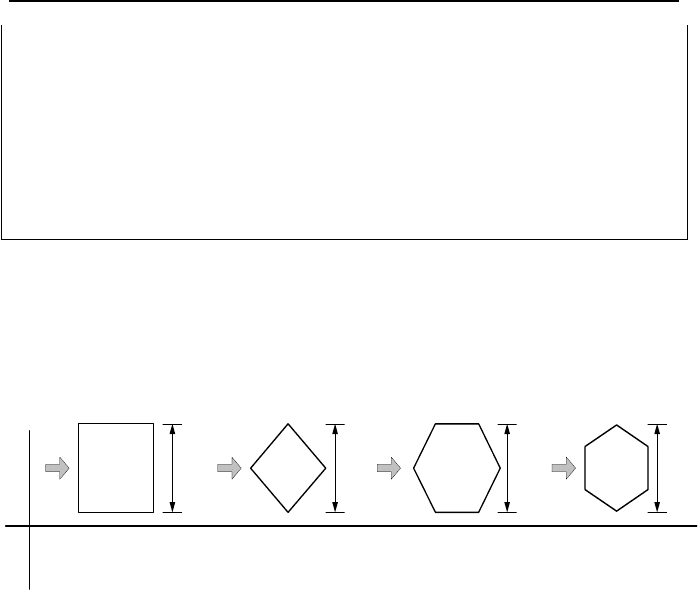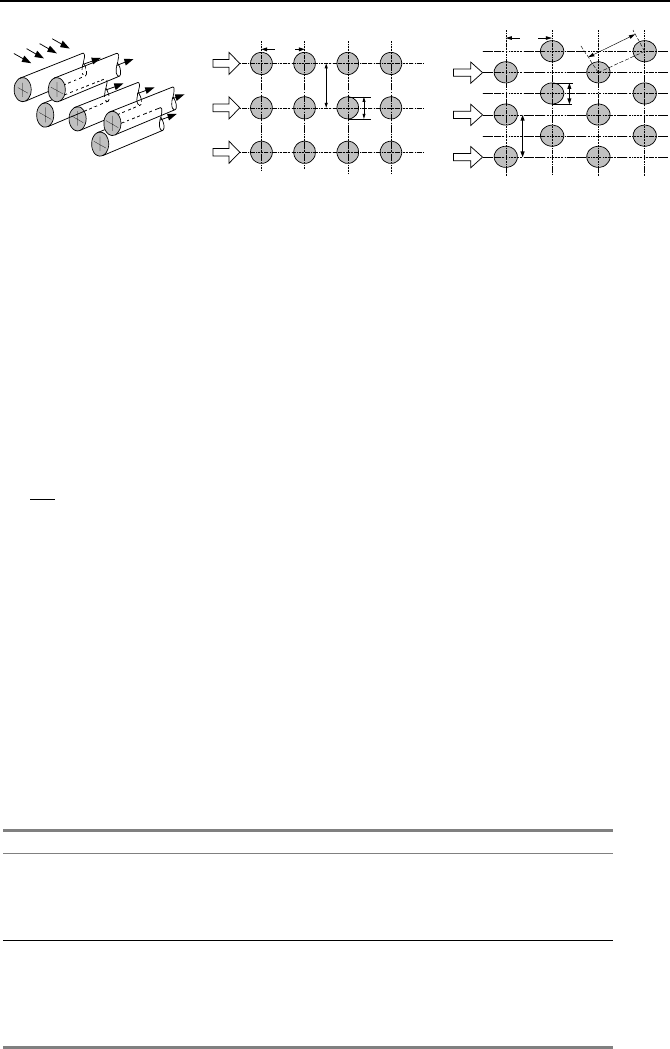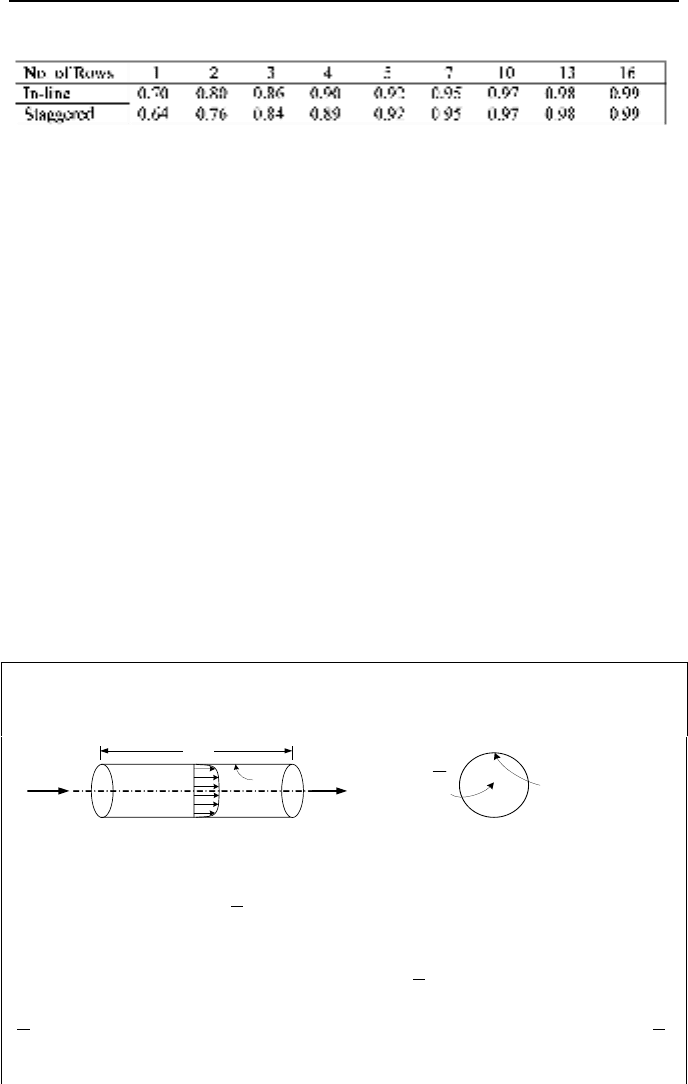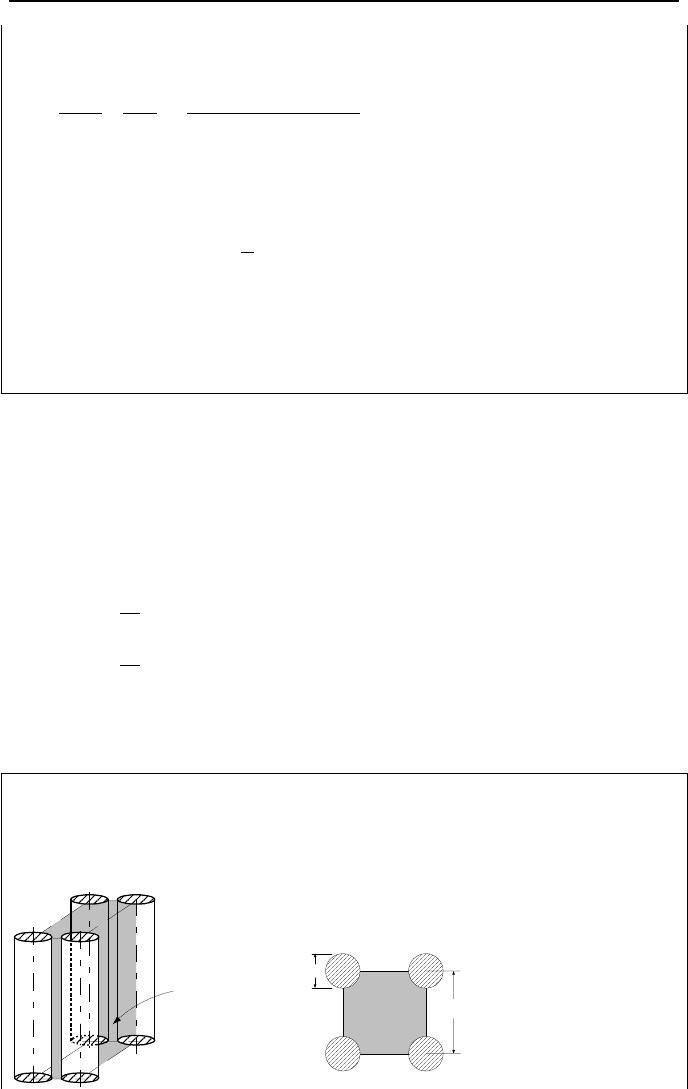Massoud M. Engineering Thermofluids: Thermodynamics, Fluid Mechanics, and Heat Transfer
Подождите немного. Документ загружается.


532 IVb. Heat Transfer: Forced Convection
The constants of integration c
1
and c
2
can be found from the following boundary
conditions. At r = 0, due to symmetry,
∂T/∂r = 0. This results in c
1
= 0. If tem-
perature at r = 0 is known (i.e., T
CL
= T(r = 0)), then c
2
= T
CL
. Substituting for c
1
and c
2
, temperature profile in the flow is found as:
()
»
»
¼
º
«
«
¬
ª
¸
¹
·
¨
©
§
−
¸
¹
·
¨
©
§
∂
∂
+=
42
2
max
4
1
4
1
R
r
R
rR
V
x
T
TT
xCL
α
IVb.2.16
Given the fluid velocity and temperature at the pipe centerline, we can find fluid
temperature at any cross section for a given axial and radial location by using
Equation IVb.2.16. For example, the wall temperature T
s
at any axial location is
obtained by setting r = R to find:
()
4
1
4
3
2
max
R
V
x
T
TT
xCLs
∂
∂
+=
α
However, the most important application of Equation IVb.2.16 is in finding the
fluid bulk temperature. This is obtained by substituting for temperature profile in
Equation IVb.1.4 and carrying out the integrals to find:
()
4
1
24
7
2
max
R
V
x
T
TT
xCLf
∂
∂
+=
α
IVb.2.17
We now find heat transfer coefficient from the fact that:
Rryfs
rTkyTkTThq
==
∂∂=∂∂−=−=
′′
)/()/()(
0
The derivative of temperature in the radial direction is found as (∂T/∂r)
r = R
=
[(V
x
)
max
R/4
α
]∂T/∂x then
D
k
R
k
RVxT
xTRVk
TT
rTk
h
x
x
s
Rr
11
48
11
24
)4/())(/)(/1)[(24/11(
/]4/)[(
)/(
2
max
max
==
∂∂
∂∂
=
−
∂∂−
=
=
α
α
IVb.2.18
From h = 48k/11D we find Nu = hD/k = 48/11. Thus, for laminar flow inside
pipes Nu = constant.
The topic of internal flow of fluids in heated conduits is discussed in more de-
tails in Section 2 of Chapters VIa and VIe. Figure IVb.2.2 shows the temperature
profiles for two interesting cases of constant heat flux specified at the channel wall
(Figure IVb.2.2(a)) and an isothermal channel wall (Figure IVb.2.2(b)).

2. Analytical Solution 533
T
s
T
f
x
T
s
T
f
x
x
y
Fully
developed
Entrance
region
T
s
(x)
T
f
(x)
P
i
p
e
w
a
l
l
t
e
m
p
e
r
a
t
u
r
e
F
l
u
i
d
b
u
l
k
t
e
m
p
e
r
a
t
u
r
e
s
q
′′
developed
x
y
Fully
T
s
(x)
T
f
(x)
Entrance
region
s
q
′′
F
l
u
i
d
b
u
l
k
t
e
m
p
e
r
a
t
u
r
e
Pipe wall temperature
(a) (b)
Figure IVb.2.2. Axial temperature profiles (a) constant wall heat flux and (b) constant wall
temperature
Example IVb.2.5. Consider the fully developed flow of an incompressible vis-
cous flow at velocity V in a heated pipe of diameter D and length L. Heat flux of
s
q
′′
= f(x) is applied to the channel wall. Derive the axial temperature distribution
in terms of
s
q
′′
, V , D, L, and
ρ
.
x
0
L
)()( xfxq
s
=
′′
dx
D
V
Control Volume
Solution: We write the mass and energy balance for the shaded control volume at
steady state condition:
[
]
[]
DdxxqdhDV
s
ππρ
)()4/(
2
′′
=
Since flow is subcooled, dh = c
p
dT. Substituting and integrating from x = 0 to any
x yields:
³
x
sff
dxxqVDTxT
0
)()/4()0()(
′′
+=
ρ
where T
f
(x) is the fluid bulk temperature. If the function representing the wall heat
flux is specified, we can find T
f
(x). For a special case of constant wall heat flux,
s
q
′′
= constant = q
′′
, we find:

534 IVb. Heat Transfer: Forced Convection
)/4()0()( VxqDTxT
ff
ρ
′′
+=
IVb.2.19
Equation IVb.2.19 (Figure IVb.2.2(a)) is applicable to any flow regime whether
laminar or turbulent as long as flow remains subcooled so that T
f
(x = L) <
T
sat
(P
system
). In Equation IVb.2.19, for x = L, we have T
f
= T
f
(L) confirming that
the results are consistent with an overall energy balance over the tube length:
)(
0==
−=
xLxp
TTcmQ
IVb.2.20
3. Empirical Relations
In Section 2 we were able to find analytical solutions only for such limited cases
as forced convection heat transfer for flow over flat plate and inside conduits. In
these cases, we considered steady and laminar flow. Additionally, we used such
simplifying assumptions as incompressible laminar flow, thermal properties inde-
pendent of temperature, no internal heat generation, and negligible heat transfer
from thermal radiation. Still we had to resort to empirical correlations to increase
the range of applicability of Nu number.
In common practice an ideal situation to satisfy all the required conditions gen-
erally does not exist. While in many cases a steady incompressible flow can be
assumed with approximately constant thermal properties in a specified range of
temperature, flow cannot be guaranteed to remain laminar. Indeed, except in
some special cases, flow is generally turbulent. Fortunately, in the majority of
cases the Nusselt number for forced convection heat transfer in turbulent flow has
the same functional relationship with the Pr and the Re numbers as shown in
Equation IVb.2.11. Thus, all we need to do is to find constants c
1
, c
2
, and c
3
.
These are generally found in experiments, hence the relations are known as em-
pirical correlations. To demonstrate the relation between theory and experiment,
let’s rearrange Equation IVb.2.11 and take the logarithm of each side of the rear-
ranged formula:
(
)
ReloglogPr/Nulog
21
3
cc
c
+=
This equation shows that the logarithm of (
2
PrNu/
c
) is a linear function of the
logarithm of the Reynolds number. This functional relation is verified by variety
of tests using different fluids and pipe diameters.
3.1. External Turbulent Flow over Flat Plates
Assuming a turbulent velocity profile V
x
/(V
x
)
f
= (y/δ)
1/7
, substituting in Equation
IVb.2.5 and integrating, we find the boundary layer thickness for turbulent flow
over a flat plate, heated at the leading edge as:
5/1
Turbulent
Re/37.0į
x
x= 5E5 < Re
x
< 1E7 IVb.3.1

3. Empirical Relations 535
Comparing the thickness of turbulent versus laminar boundary layer, given by
Equation IVb.2.4, we find that
δ
Turbulent
= 0.074δ
Laminar
3.0
Re
x
. Since Re
x
> 5E5,
then
δ
Turbulent
is at least 4 times thicker than δ
Laminar
. Since turbulence is associated
with the eddy diffusivity, being random fluctuations as opposed to the molecular
diffusion in the laminar flow, the fluid Pr number does not influence the boundary
layer thickness in turbulent flow. This implies that in turbulent flow,
δ = δ’. The
local Nu number is given by:
3/15/4
PrRe0296.0Nu
xx
= 0.6 < Pr < 60 IVb.3.2
and the average Nu number by (Whitaker):
4/143.05/4
)/(Pr)9200(Re036.0Nu
sfL
µµ
−= IVb.3.3
where properties are found at T
f
except for
µ
s
, which is found at T
s
. This correla-
tion is valid for 2E5 < Re
L
< 5.5E6, 0.7 < Pr < 380, and 0.26 <
µ
f
/
µ
s
< 3.5.
3.2. External Flow over Conduits
We already analyzed external flow over flat plates. There are two more cases to
be considered in external turbulent flow. These are flow over single cylinders and
spheres as well as flow over a cluster of cylinders and spheres. For example, flow
across tube banks is of much interest in heat exchanger technology.
Cross Flow over Cylinders
This includes flow over cylinders with circular or non-circular cross section.
When a fluid flows over curved surfaces, depending on the Reynolds number of
the flow, the boundary layer may become separated from the surface. This phe-
nomenon is too complicated to have analytical solutions. Ironically, the boundary
layer separation occurs mostly at very low to moderate Reynolds numbers (10 –
1000). When Re becomes greater than 3E5, the boundary layer separation is de-
layed. Therefore, for flow over curved surfaces, even for laminar flow we have to
resort to empirical correlations such as that recommended by Whitaker:
(
)
()
25.0
5/23/22/1
/PrRe06.0Re4.0Nu
sf
µµ
+= IVb.3.4
Equation IVb.3.4 is valid for 40 < Re < 1E5, 0.65 < Pr < 300, and 0.25 <
µ
f
/
µ
s
<
5.2. All properties are found at the free stream temperature except for the
µ
s
,
which is developed at the surface temperature.
Example IVb.3.1. The surface of a cylinder (D = 10 cm and L = 20 cm) is main-
tained at 127 C. The cylinder is exposed to the cross flow of air. The air velocity,
temperature, and pressure are 40 m/s, 27 C, and 1 atm, respectively. Assuming a
very low surface emissivity, find the rate of heat transfer by convection.

536 IVb. Heat Transfer: Forced Convection
Solution: We find air properties at T
f
= 300 K: v = 15.89E-6 kg/m
3
,
µ
f
= 18.46E-6
N·s/m
2
,
µ
s
= 2.3E-6 N·s/m
2
, Pr = 0.707, and k = 0.0263 W/m·C.
We now find the Reynolds number:
Re = VD/v= 40 × 0.1/15.89E-6 = 251,730
Nu = [0.4 × (251,730)
1/2
+ 0.06 × (251,730)
2/3
] × (5.83)
2/5
× (18.46E-6/2.3E-6)
0.25
§ 1500
h = Nu(k/D) = 1500 × (0.0263/0.1) = 394 W/m
2
·C.
Q
= h(
π
DL)(T
s
– T
f
) = 394 × (
π
× 0.1 × 0.2) × (127 – 27) § 2.5 kW.
For non-circular cylinders, we use Table IVb.3.1 as recommended by Jakob.
All properties are found at the film temperature
Table IVb.3.1. Coefficients c
1
and c
2
for non-circular cylinders
3/1
1
PrReNu
2
c
c=
V
f
(a)
V
f
V
f
V
f
(b)(c)(d)D D D D
c
1
0.102 0.246 0.153 0.160
c
2
0.675 0.588 0.638 0.638
The range for Re number in Table IVb.3.1 is 5E3 < Re < 1E5 except for case
(d) which the range is 5E3 < Re < 1.95E4.
Flow over Spheres
The Nusselt number over a sphere having diameter D can be found from
Whitaker’s correlation:
(
)
()
4/1
5/23/22/1
/PrRe06.0Re4.02Nu
sf
µµ
++= IVb.3.5
applicable for 3.5 < Re < 8E4 and 0.7 < Pr < 380. The Reynolds number is devel-
oped based on D. All properties are found at the free stream temperature except
for
µ
s
, which is found at T
s
.
Cross Flow over Bank of Tubes
Shown in Figure IVb.3.1 is cross flow over a tube bank arranged in either in-line
or staggered configuration.

3. Empirical Relations 537
V
f
T
f
D
S
L
S
T
S
L
S
T
D
S
D
V
f
T
f
Figure IVb.3.1. Cross Flow over tube banks arranged in in-line and staggered configura-
tions
Note that in both configurations the velocity vector of the fluid flowing over the
tubes is perpendicular to the velocity vector of the fluid flowing inside the tubes.
Our goal is to obtain the heat transfer coefficient for the fluid which is flowing
over the tubes. For the fluid flowing inside the tubes, the heat transfer coefficient
is discussed in Sections 2.2 and 3.3 for laminar and for turbulent flows, respec-
tively. Tubes are spaced by longitudinal pitch (S
L
) and transverse pitch (S
T
). Lat-
eral pitch S
D
is pertinent to the staggered arrangement. Maximum flow velocity
occurs in the gap between the adjacent rods having a height of S
T
−
D. Form a
mass balance we find V
max
= V
f
S
T
/(S
T
−
D). The average Nu number is recom-
mended by Zhukauskas as:
25.036.0
max1
)Pr(Pr/PrReNu
2
s
c
c=
IVb.3.6
where c
1
and c
2
are given in Table IVb.3.2. This correlation is valid for 0.7 < Pr <
500, 1000 < Re
max
< 2E6, and tubes bundles with 20 or more rows of tubes. If the
number of rows is less than 20, then a correction factor must be used. To apply
the correction factor, the Nusselt number is calculated for a tube bundle with 20
rows of tubes. Then the correction factor C is obtained from Table IVb.3.3 so that
Nu
<20
= CNu
20
All fluid properties in Equation IVb.3.6 are found at the arithmetic mean of the
fluid inlet and outlet temperatures except for Pr
s
, which is found at the surface
temperature T
s
.
Table IVb.3.2. Coefficients in Equation IVb.3.6
Geometry Re
max
c
1
c
2
10 – 100 0.80 0.40
100 – 1E3 (Treat as a single cylinder)
1E3 – 2E5 0.27 0.63
In-line
> 2E5 0.21 0.84
10 – 100 0.90 0.40
100 – 1E3 (Treat as a single cylinder)
1E3 – 2E5
i
0.35(S
T
/S
L
)
0.2
0.60
1E3 – 2E5
j
0.40 0.60
Staggered
> 2E5 0.02 0.84
i For S
T
/S
L
< 2
j For S
T
/S
L
> 2

538 IVb. Heat Transfer: Forced Convection
Table IVb.3.3. Correction factor C for bundles with less than 20 tubes
3.3. Internal Turbulent Flow
A frequently used correlation in internal turbulent flow for single-phase heat trans-
fer is the Dittus-Boelter correlation, originally developed in the 1930s for automo-
tive engineering:
n
DD
PrRe023.0Nu
8.0
= IVb.3.4
where n = 0.4 if T
s
> T
f
and 0.3 if T
s
< T
f
. Therefore;
3.08.0
PrRe023.0Nu
DD
= (Fluid is cooled) IVb.3.4-1
4.08.0
PrRe023.0Nu
DD
= (Fluid is heated) IVb.3.4-2
The range of applicability includes 0.7 < Pr < 160, Re
D
> 10,000, and L/D > 10.
Seider-Tate later modified this correlation for cases with large differences between
the surface and the fluid bulk temperature by accounting for fluid viscosity evalu-
ated at the bulk (
µ
f
) and at the surface temperature (
µ
s
):
14.03.08.0
)/(PrRe027.0Nu
sfDD
µµ
= IVb.3.5
All properties in Equations IVb.3.4 and IVb.3.5 should be found at the fluid bulk
temperature except for
µ
s
.
Example IVb.3.2. Water at a rate of 4 kg/s enters a heated pipe at 10 C and
leaves at 30 C. The pipe has a diameter of 5 cm and its wall is maintained at 95 C.
Find the required pipe length.
T
f 1
T
f 2
T
s
L
m, c
p
.
T
f
T
s
Solution: To find L, we use Equation IVb.2.20 in conjunction with Newton’s law
of cooling:
(
)
(
)
fsffp
TThATTcm −=−
12
where T
f1
and T
f2
are the water bulk temperature at the inlet and at the exit of the
pipe. The bulk average temperature is shown by
f
T
:
f
T
= (T
f1
+ T
f2
)/2 = (10 + 30)/2 = 20 C. To find A, having
m
, T
s
, T
f1
, T
f2
, and
f
T
we need to find h:

3. Empirical Relations 539
At 20 C,
ρ
= 998.37 kg/m
3
, c
p
= 4.18 kJ/kg⋅C,
µ
f
= 0.001 N·s/m
2
, k = 0.6 W/m·C,
and Pr = 6.9
Re =
A
DmVD
µµ
ρ
= = 859,101
)4/05.0(001.0
05.04
2
=
××
×
π
Nu = 0.023Re
0.8
Pr
0.4
= 0.023 × 101,859
0.8
× 6.9
0.4
= 505.4 (580 if Equation IVb.3.5
is used)
h = Nu × k/D = 505.4 × 0.6/0.05 = 6065 W/m
2
·C
A =
(
)
(
)
fsffp
TThTTcm −− /
12
Substituting values:
A =
π
DL =
π
× 0.05 × L = 4 × 4180 × (30 – 10)/[6065 × (95 – 20)]
Solving for the pipe length, we find L = 4.68 m.
Equations IVb.3.4 is applicable to fluids flowing inside conduits. However, the
heat transfer coefficient of water flowing in rod or tube bundles parallel to the axis
of the rods or tubes should be calculated from:
n
DD
C PrReNu
8.0
= IVb.3.6
where coefficient C is found from:
024.0042.0 −=
D
s
C
Square array (1.1 ≤ s/D ≤ 1.3) IVb.3.7(a)
024.0026.0 −=
D
s
C
Triangular array (1.1 ≤ s/D ≤ 1.5) IVb.3.7(b)
as recommended by Weisman. In these relations s and D are the pitch and the di-
ameter of a tube or a rod, respectively.
Example IVb.3.3. Consider the fully developed flow of water in a rod bundle at a
rate of 2845 lbm/h. System pressure is 1020 psia and water bulk temperature is
525 F. Find the heat transfer coefficient. Use rod pitch = 0.738 in and rod diame-
ter = 0.563 in.
Control
Volume
s
d

540 IVb. Heat Transfer: Forced Convection
Solution: We first find the channel flow area and the equivalent diameter:
A
Flow
= s
2
– 4(
π
d
2
/16) = 0.738 × 0.738 –
π
(0.563)
2
/4= 0.2956 in
2
= 2E-3 ft
2
.
P
Wetted
= 4(
π
d/4) =
π
d = 1.768 in
/2956.0[4=
e
D 1.768] = 0.668 in
Water properties at P = 1020 psia and T = 525 F are v = 0.02166 ft
3
/lbm or
ρ
=
46.17 lbm/ft
3
V = m
/(
ρ
A) = (2845/3600)/(47.62 × 2E-3) = 8.08 ft/s
Re =
ρ
VD
e
/
µ
= [47.62 × 8.08 × (0.668/12)]/(0.23766/3600) = 323,568
Since water is heated up, we use:
4.08.0
PrReNu C
k
hD
Water
channel
==
At T = 525 F, we also find Pr = 0.8726 and k = 0.3377 Btu/h·ft·F. Since s/D § 1.3,
C is calculated as:
C = 0.042 × (0.738/0.563) – 0.024 = 0.031055
759)8726.0(568,323031055.0PrReNu
3/18.0048.0
=×=== C
k
hD
Water
channel
h = Nu × k
Water
/D
e
= 759 × 0.3377/(0.668/12) = 4606 Btu/h·ft
2
·F
3.4. Internal Flow of Liquid Metals
An interesting feature of liquid metals, such as bismuth, mercury, and sodium, is
that due to their high thermal conductivity, heat transfer by conduction plays a
much more important role than in ordinary liquids and gases. For liquid metal
properties see Table A.IV.6(SI). Thus, the Nu number for liquid metals includes a
constant, to account for heat transfer by conduction superimposed on the term ac-
counting for flow velocity and hence heat transfer by convection.
For flow in circular tubes, Lyon-Martinelli correlation is recommended for iso-
thermal wall:
Nu = 5.0 + 0.025Pe
0.8
IVb.3.8
where Pe is the Peclet number given by Pe = Re Pr. For uniform wall heat flux,
The Seban-Shimazaki correlation, valid only for s/D > 1.35 is used:
Nu = 7.0 + 0.025Pe
0.8
IVb.3.9
For flow of liquid metals parallel to heated rods, arranged in a hexagonal array,
Dwyer recommends:
Nu = 6.66 + 3.126(s/D) + 1.184(s/D)
2
+ 0.0155(ψPe)
0.86

Questions and Problems 541
where s/D is the ratio of the pitch to diameter for the array and ψ is given by (La-
marsh and Baratta):
281.1
1.4
)1000Pr(Re/
)/0.942(
1
ȥ
Ds
−=
QUESTIONS
− What does k in Biot number and in Nusselt number stand for? State the inter-
pretation of each number.
− What is the difference between V
x
and (V
x
)
f
?. Similarly, identify the difference
between T and T
f
.
− Which scientist first identified the boundary layer? What is the significance of
the Prandtl number?
− In the analytical derivation of external and internal temperature profiles, we as-
sumed thermal properties to be independent of temperature. Is it then correct to
say that in such circumstance the temperature and the velocity fields are inde-
pendent?
− What is the von Karman method for the development of the energy equation in
the boundary layer?
− How accurate is the thickness of boundary layer obtained from a force balance
in the boundary layer?
− What are the key assumptions, which were made to obtain an analytical solu-
tion for the thickness of the thermal boundary layer?
− Consider heat convection for laminar flow of water in a pipe. What is the ef-
fect of doubling the flow rate on the Nusselt number? What is the effect of us-
ing motor oil instead of water on h?
− What is the difference between the Dittus-Boelter and the Seider-Tate correla-
tions? What is the range of applicability for the Pr number? Are these correla-
tions applicable to liquid metals?
PROBLEMS
1. Start with Equation IVb.2.7 and obtain an approximate relation for the thick-
ness of the hydrodynamic boundary layer. Compare your result with the exact so-
lution.
2. Start with Equation IVb.2.6 and derive a relation for the thickness of the hy-
drodynamic boundary layer by assuming a linear relation for velocity versus dis-
tance, i.e., V
x
/(V
x
)
f
= y/δ.
3. Assume a two-dimensional flow over a flat plate. Use the result of Problem 1
for the thickness of the boundary layer and the velocity profile for V
x
, as given by
